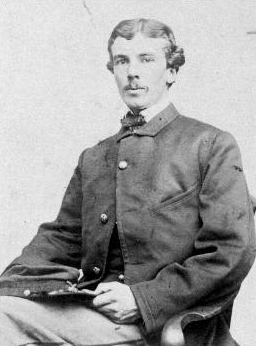Fallen at Cedar Creek: Charles Russell Lowell, Jr.

On October 15, 1864, Colonel Charles Russell Lowell Jr. wrote to his wife from the camp of the 2nd Massachusetts Cavalry near Cedar Creek in the Shenandoah Valley:
“I’ve only ten minutes to write to you; I was out all this morning, junketing at the various headquarters, and only came home to dinner at two o’clock. Since that, has come an order to get in light marching order, and be in readiness to move. I conjecture a raid is on foot for our Division,—perhaps to Charlottesville,—if so, you will not hear from me again for a week or even ten days.
“I think Sheridan will have to fight one more battle here, probably while we are gone,—i am sorry to miss it, but perhaps we shall be of more use where we are going. You will know that I am safe, at any rate, —so safe do I feel tonight that I shall be riding Berold; I rode him his morning, too, in making my calls. I heard for the first time that poor Colonel Wells of the Thirty-Fourth Massachusetts was killed in the attack the Rebs made on our camps day before yesterday,—he was considered an excellent officer.
“What a letter this for the last one for ten days, but you know how I am when I have anything on foot, I’m all distracted.”
The hoped for raid turned out to be a comparatively short ride to Front Royal, Virginia, to destroy some supplies, then the regiment was back in camp. Colonel Lowell penned other letters to his wife, mother, and a few friends over the next days. Part of his letter on the 17th to his mother reads:
“There’s really nothing to tell here… We are in a glorious country, with fine air to breathe and fine views to enjoy; we are kept very active, and have done a good deal of good work; I have done my share, I think,—but there’s nothing to make a letter of.”
Four days after the letter to his wife and two days after the letter to his mother, Colonel Lowell fought at the Battle of Cedar Creek, leading his regiment in a charge toward Middletown as Union troops rallied to reclaim their camps and drive back the Confederates. Dangerously wounded in the chest during an early charge, Lowell insisted on remaining with his regiment and led another attack, galloping forward at the head of his regiment. A second wound threw the colonel from his horse, and he was carried into a nearby home/field hospital. Paralyzed by his second injury, Lowell lingered for hours and bade farewell to his officers who came to see him after the Union victory had been secured on the battlefield. He died quietly on October 20, 1864, only twenty-nine years old.
Today, a small granite marker sits near the corner of Main Street and First Street in Middletown near the location where Lowell fell. (Lowell is buried in Massachusetts.)

Lowell is a fascinating character. One of my top 10 favorite Civil War books is the biography of him by Carol Bundy.
The Lowell marker pictured is located next to the Wayside Inn in Middletown, and directly across the street (Main Street/Valley Turnpike) is the house where Lowell died. The area where Lowell fell, mortally wounded, is several miles away on the outskirts of Middletown just east of present day I-81.
Hello Blake,
I was wondering more specifically the location where Lowell fell…was it NE of Middletown?
Also, which house across the street was the one where he died? I’m vaguely familiar with the vicinity of the Wayside Inn, so just trying to picture correctly. Also, was the building of the Wayside Inn there during the battle and if so, was it used for anything? Many thanks Blake for any information you are able to provide.
All the best,
Dayton
Thanks for the interesting article.
Great article. One of those upper class society types whose deaths in battle always filled the papers. Lowell’s wife was a bluestocking Shaw who embraced the scientific determinism of the “Progressives” in her social reform work. Rather frightening views of what should be done to prevent the “breeding” of the perceived “lower classes”.
Great article. The 2nd Mass Cav have a great regimental history that was reprinted not too long ago.
His wife was Robert Gould Shaw’s sister Josephine Shaw. Josephine dedicated her life to serving the poor of New York after her husband’s death. She was the first actual woman to have a monument in New York City, a fountain in Bryant Park next to the famous Library.